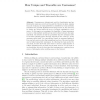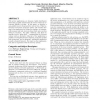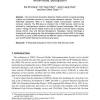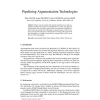158
Voted
CORR
2011
Springer
14 years 4 months ago
2011
Springer
Abstract. Usernames are ubiquitously used for identification and authentication purposes on web services and the Internet at large, ranging from the local-part of email addresses ...
175
Voted
TSMC
2010
14 years 7 months ago
2010
Business Process Execution Language for Web Services (BPEL) is becoming the industrial standard for modeling web service-based business processes. Behavioral compatibility for web ...
137
Voted
SIGSOFT
2010
ACM
14 years 7 months ago
2010
ACM
Web service applications are dynamic, highly distributed, and loosely coupled orchestrations of services which are notoriously difficult to debug. In this paper, we describe a use...
222
Voted
SECO
2010
14 years 7 months ago
2010
In the Search Computing project, Web services are modeled by the Semantic Resource Framework (SRF). In this article, we argue that the SRF could benefit from ontological concepts b...
176
Voted
JIPS
2010
14 years 7 months ago
2010
The trend of Next Generation Networks' (NGN) evolution is towards providing multiple and multimedia services to users through ubiquitous networks. The aim of IP Multimedia Sub...
147
Voted
JCIT
2010
14 years 7 months ago
2010
With an expanding of Web services giving same functionalities, Quality of Service (QoS) is becoming an important criterion for selection of the best available service. So users ne...
175
click to vote
WWW
2011
ACM
14 years 7 months ago
2011
ACM
Over the past few years, the discussion between the two major architectural styles for designing and implementing Web services, the RPC-oriented approach and the resourceoriented ...
133
click to vote
JWSR
2011
14 years 7 months ago
2011
: Semantic Web Services (SWS) aim at the automated discovery, selection and orchestration of Web services on the basis of comprehensive, machine-interpretable semantic descriptions...
142
Voted
COMMA
2010
14 years 7 months ago
2010
Abstract. Software tools for working with argument generally exist as large systems that wrap their entire feature set in the application as a whole. This approach, while perfectly...
208
click to vote
CASCON
2010
14 years 9 months ago
2010
For a system of distributed processes, correctness can be ensured by (statically) checking whether their composition satisfies properties of interest. However, web services are dis...






